Cinema is no stranger to the Day of the Dead. One need look no further than recent animated films like Pixar’s Coco or Guillermo del Toro’s The Book of Life. The Mexican holiday can even be seen in Spectre’s opening set piece, or in Alejandro Jodorowsky’s Endless Poetry. But here at Fandor, it’s out with the new and in with the old — let’s flashback to the Golden Age of Mexican cinema and take a look at Roberto Gavaldón’s 1960 masterpiece Macario, a film that remains an essential depiction of the Day of the Dead.
Perhaps I’ll let the film itself explain the Day of the Dead. Macario opens with the following text: “The Day of the Dead is celebrated in Mexico in a unique way because Mexicans have a very peculiar sense of death. They make toys in the form of skeletons, bake bread for the dead, and skulls of sugar or chocolate. On this day they place offerings of flowers and food in their homes for their departed relatives to eat and drink.”
But unfortunately, there are neither sugar skulls nor pan de Muerto at Macario’s (Ignacio López Tarso) home. In fact, a scant amount of beans and tortillas barely feeds his five children. Meanwhile, a local landowner orders three turkeys for his family’s sumptuous celebration. Similarly, other families in Macario’s village spare no expense, decorating their ancestors’ tombs with lush ornamentations. Macario is left frustrated with his lifelong poverty, yearning for a turkey for himself.
So, his wife responds by stealing a turkey for him, and Macario heads to the forest to eat it. Along the way, he meets three strangers who, unbeknownst to him, are the Devil (José Gálvez), God (José Luis Jiménez), and a personification of death (Enrique Lucero). They each ask him for a piece. Macario turns away the Devil and God, but he makes a pact with Death, who grants him the gift of healing. But over the course of the film, the pact turns sour and Macario is accused of witchcraft. The film’s premise positions it as a sort of fable, weaving in a moral lesson while melding the real with the fantastical.
Upon its release at the 1960 Cannes Film Festival, the film earned widespread praise and was the first Mexican film to earn an Academy Award nomination for Best Foreign Language Film. But that’s no surprise, given that Roberto Gavaldón was one of the most respected directors in Mexico at the time — one of his first films, La Barraca, earned ten Mexican Academy of Film Awards in 1946.
What’s more, Macario is based on a story by B. Traven, a German anarchist who lived in Mexico, and whose identity is surrounded by mystery. But we do know that he wrote The Treasure of the Sierra Madre, which was famously adapted by John Huston in 1948. As a result, the credentials behind Macario are just as impressive as the film. Still, some Mexican critics initially labeled the film a hollow export — a mere postcard for foreigners. But of course, Macario is now hailed as a classic of Mexican cinema.
And if you don’t believe me, just look to Ignacio López Tarso’s sublime performance as Macario, which earned him a Golden Gate Award for Best Actor at the 1960’s San Francisco International Film Festival. Additionally, I’d be remiss if I didn’t mention Gabriel Figueroa’s gobsmacking cinematography, which includes a superb chiaroscuro style, and low-angle shots that capture the grandeur of the Mexican sky. In fact, the film was shot on location in the town of Taxco, the grottos of Cacahuamilpa, and in the Zempoala Lagoons, adding a profound, natural beauty to the film.
But Macario saves the best for last — the film’s most striking feature is its confounding ending. We see Macario conversing with Death, among hundreds of melting candles, in what appears to be the underworld. As a result, we’re presented with a mystery — did Macario die from eating the turkey at the film’s start? After all, Macario said that he only shared his turkey with death to at least “die with a full stomach.”
Ultimately, Macario is worth seeking out, at the very least, to deduce the ending for yourself. The film holds a special place in the history of Mexican cinema, and nearly sixty years after its release, Macario remains the quintessential film about the Day of the Dead.




